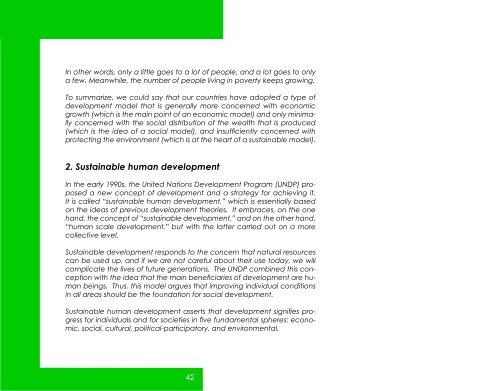in English - Handicap International
in English - Handicap International
in English - Handicap International
Create successful ePaper yourself
Turn your PDF publications into a flip-book with our unique Google optimized e-Paper software.
In other words, only a little goes to a lot of people, and a lot goes to only<br />
a few. Meanwhile, the number of people liv<strong>in</strong>g <strong>in</strong> poverty keeps grow<strong>in</strong>g.<br />
To summarize, we could say that our countries have adopted a type of<br />
development model that is generally more concerned with economic<br />
growth (which is the ma<strong>in</strong> po<strong>in</strong>t of an economic model) and only m<strong>in</strong>imally<br />
concerned with the social distribution of the wealth that is produced<br />
(which is the idea of a social model), and <strong>in</strong>sufficiently concerned with<br />
protect<strong>in</strong>g the environment (which is at the heart of a susta<strong>in</strong>able model).<br />
2. Susta<strong>in</strong>able human development<br />
In the early 1990s, the United Nations Development Program (UNDP) proposed<br />
a new concept of development and a strategy for achiev<strong>in</strong>g it.<br />
It is called “susta<strong>in</strong>able human development,” which is essentially based<br />
on the ideas of previous development theories. It embraces, on the one<br />
hand, the concept of “susta<strong>in</strong>able development,” and on the other hand,<br />
“human scale development,” but with the latter carried out on a more<br />
collective level.<br />
Susta<strong>in</strong>able development responds to the concern that natural resources<br />
can be used up, and if we are not careful about their use today, we will<br />
complicate the lives of future generations. The UNDP comb<strong>in</strong>ed this conception<br />
with the idea that the ma<strong>in</strong> beneficiaries of development are human<br />
be<strong>in</strong>gs. Thus, this model argues that improv<strong>in</strong>g <strong>in</strong>dividual conditions<br />
<strong>in</strong> all areas should be the foundation for social development.<br />
Susta<strong>in</strong>able human development asserts that development signifies progress<br />
for <strong>in</strong>dividuals and for societies <strong>in</strong> five fundamental spheres: economic,<br />
social, cultural, political-participatory, and environmental.<br />
42

















